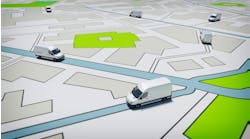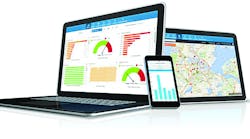The problem with fleet management is that there is so much to manage. Your fleet is how much you’re spending on gas, maintenance and replacement vehicles. Your fleet is which service technician is where, when and for how long. Your fleet — if you’re wrapping it right — is a major marketing tool, and potentially a marketing nightmare if your drivers are prone to accidents. Your fleet is probably where most of your parts, tools and equipment are at any given time.
Your fleet is at once the lifeblood of your company and a three-tiered chess match pitting your resources against your service area. Winning the game means success for your company so, like it or not, you need a fleet management system.
Those systems today are collecting more information and doing more with it than ever before. And luckily, the best of those systems are designed to be user-friendly, tailored to match the specific needs of individual businesses. Here are three companies on the cutting-edge, and what their fleet management systems are offering that could change your business for the better.
Fleetmatics
Todd Ewing is Director of Product Management for Fleet Solutions for Fleetmatics (www.fleetmatics.com) and the Reveal Fleet Tracking System. Fleetmatics is a GPS-based, full-featured, scalable fleet management system ideal for small- to mid-sized businesses offered as a monthly subscription service.
“The real value proposition of our product revolves around visibility,” Ewing says, “having an objective sense of what’s actually happening out in the field is something that people understand — in many cases sometimes too late — that they desperately need.”
In this age of the smartphone, where some people shopping for a fleet management system see the added hardware component of a GPS as a barrier to purchase, Ewing sees it instead as the bedrock — the objective source of data the rest of the system is built upon.
“The truck is the truth,” Ewing says. “The truck doesn’t have any motivations, it is only where it is and has no reason to say otherwise… it tends to be a good proxy for the activity of the driver in terms of duration, time on site, proof of service.”
That hardware component also collects telematics data from the vehicle itself providing information on driver behavior. Everything from acceleration to hard turns to whether or not the driver was wearing a seatbelt.
So if a customer is charged for four hours but says the tech was only there 20 minutes, or if a call comes in about a driver driving erratically but the driver claims they were just fine, or in any one of a thousand possible disputes that puts the service manager in the middle between a valued employee and a valuable customer relationship, that objective data is there.
“You know what happened,” Ewing says, “regardless of who’s right or wrong, at least you can have confidence in the answer and can operate your business more successfully as a result.”
Other advantages of the Fleetmatics system include a high level of integration with the back-end of the business, be it scheduling, payroll, truck inventory or even the individual skill sets of various technicians. Naturally, the company prefers to integrate with it’s own proprietary solution, Fleetmatics Work, but will find a way to integrate with most third party applications.
“The market is varied,” Ewing explains, “and there are a lot of workforce systems that are very vertical. There are some that are very plumbing specific, or specific to the test industry. But we’re happy to integrate with those systems too.”
The company is also committed to helping its customers use and manage the wealth of data the system can deliver.
“I’d prefer customers spent as little time in the system as possible to get value every day,” Ewing says. Making exceptions for some dispatchers and service managers who may need or want to do a deep dive into the data, his main hope is that a new user can “come in, spend 10 or 15 minutes understanding a key performance metric, an activity, and then coach that activity and change their business.”
To that end, Fleetmatics invests a lot in user experience, particularly in the program’s dashboard. The dashboard includes summary key performance indicators that users can customize. Users can also set their own benchmarks. For example, an hour’s worth of idle time may be very significant to some fleet managers, but in Georgia, in the Summertime, having drivers stay in the truck with the AC running for an hour at a time might be perfectly normal.
Reports are also designed to help users visualize information. Trend lines and stack ranks have proven very helpful to most Fleetmatics customers.
Another component of data management is the company’s customer service. The monthly subscription comes with a customer success manager that basically owns the account and manages it as the customer’s needs evolve. Which, invariably, they do.
“I would say for the first 90 to 180 days, they bought the system because they had a specific [problem] they needed to solve,” Ewing says. “As they start to get past those things… as they get a handle on them, then that customer success manager is there to help them understand what else is there. Because the thing we can’t do, and shouldn’t do, is just dump out the box on them… because it is a lot.”
Telogis
Telogis (www.telogis.com) offers several packages of solutions designed to support “enterprise level” operations. That means end-to-end, everything from assets to drivers to customers to jobs.
Again, their solutions have a hardware component installed in the vehicle. To help with that hardware integration the company has partnered with companies including Ford, GM, Mack, Volvo and John Deere.
The Telogis platform, in the field, integrates with the smartphones or personal digital assistants of the drivers, facilitating not only scheduling and job assignments, but also vehicle handovers and inspections (which can be an important factor for certain types of vehicle insurance).
And as with Fleetmatics, they have a proprietary back-end application, WorkPlan, that combines scheduling and payroll with fleet management into a single, seamless system. Telogis is also on the subscription model, meaning customer service help is never more than a phone call/e-mail/chat away.
The Telogis system can also provide answers to questions that only some larger-sized companies would have. For example, what’s the optimum location to open a new branch of the company? If you have a new customer with multiple locations, what is the projected cost of servicing that customer? For upper-level management, the system offers reports tailored to a company’s strategic development.
Dozr
The final frontier of fleet management is the new area of peer-to-peer networking.
Dozr (dozr.com) is a company that allows owners to rent out their unused or under-used equipment. The owners make money by putting their idle equipment to work, and the renters enjoy a considerable discount over comparable renting companies. Dozr is on the average about 40 percent cheaper than a standard rental.
Tim Forestell is the co-founder of Dozr. “We have contractors who will both list their equipment and others that will rent equipment,” he says. “Often they’ll do both. Or sometimes they’ll do one and realize how great a situation it is and then do the other.”
Again, emphasis on a satisfying user experience has made the company invest heavily in the system’s dashboard. Users can view what is out on rent and how much they are making for a given piece of equipment.
“We also have a calculator built in so that users can compare the cost of ownership to the cost of rental and vice-versa,” Forestell says. “It helps determine what is best for them over a given period of time: rental or purchase.”
The big advantage of the system is the flexibility it allows. “For a smaller company, it allows them to go from a small company to a medium or large company when they want to,” Forestell says, “then it allows them to scale back when the time is right.”
It also allows companies to take on new or specialty jobs that require specific equipment. For example, a plumbing and heating company that installs geothermal systems, but lacks the digging equipment needed to excavate a geothermal field.
There is no fee to join and no fee to list equipment. Dozr makes its money from a markup on the rental price.
Of course, the big question for many potential users is the same that anyone using a peer-to-peer system (Uber, Airbnb, etc.) for the first time has: How can I trust this stranger I’ve just met over the Internet? What’s going to happen if my unit goes out on rent and comes back damaged?
“Luckily, we have the answer,” Forestell says. “We have an insurance product built specifically for Dozr that protects the owner of the equipment. If it goes out on rent, they don’t need to worry, we take care of it all.”
In addition Dozr can help facilitate the logistics and transportation of every piece of equipment they rent. The renter has first option of picking it up themselves, but after that the company will work to get the equipment from point A to point B, be it across state lines or from Canada to the U.S.
“Sometimes someone will see a really great unit at a really great price in a different state,” Forestell says, “and we always say don’t be discouraged, we can get really great rates for logistics.”



